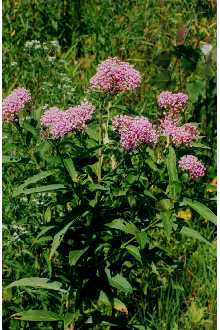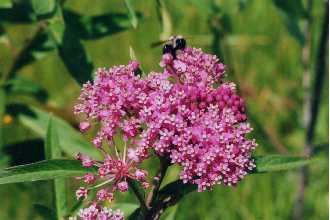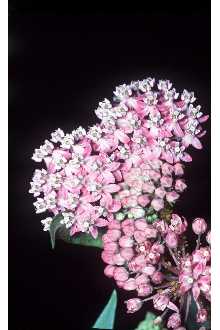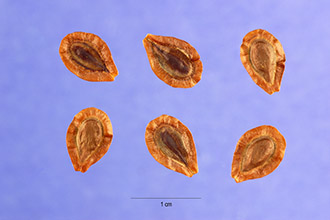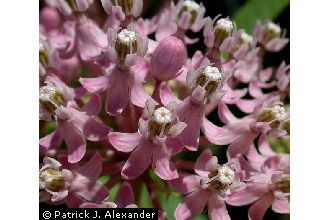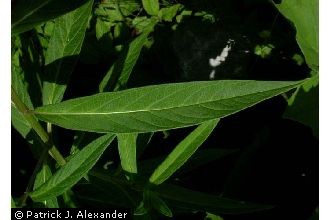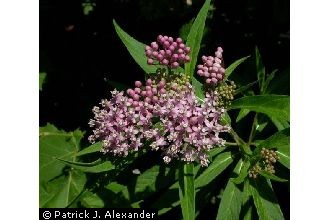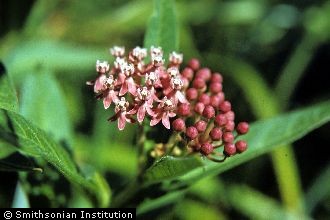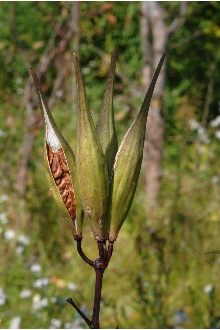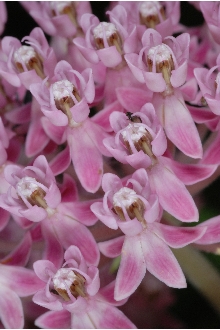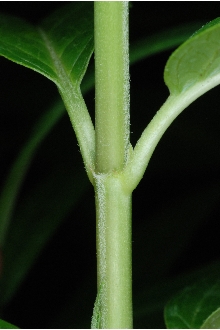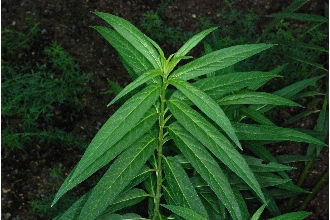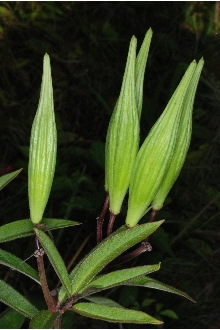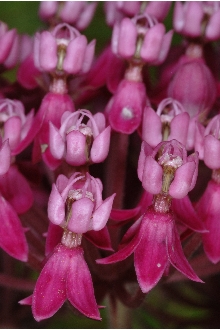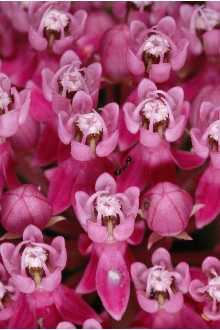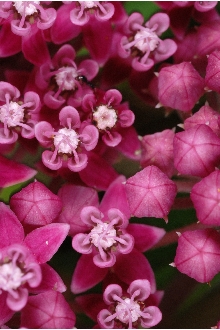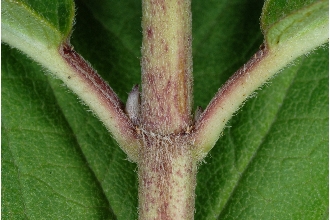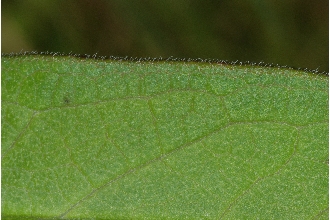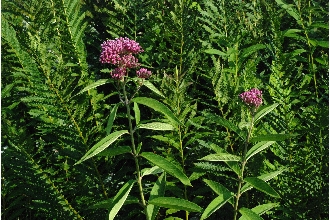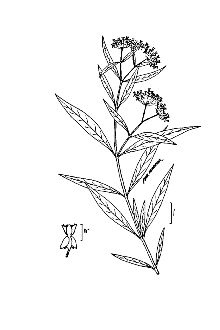Swamp Milkweed
Scientific Name: Asclepias incarnata L.
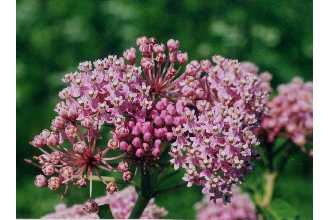
| General Information | |
|---|---|
| Usda Symbol | ASIN |
| Group | Dicot |
| Life Cycle | Perennial |
| Growth Habits | Forb/herb |
| Native Locations | ASIN |
Plant Guide
Use a soil moisture meter to monitor the soil moisture where Swamp Milkweed is planted.
Fact Sheet
Alternate Names
Rose milkweed Pleurisy Root White Indian hemp Warning: Swamp milkweed may be toxic when taken internally without sufficient preparation.
Uses
Conservation: Swamp milkweed is a native, colonizing, perennial wildflower useful for wetland rehabilitation. It is a good component of a wildlife seed mixture when seeded with native grasses and wildflowers. It prefers moisture retentive to damp soils in full sun to partial shade. Wildlife: Swamp milkweed is a favored food of monarch butterfly (Danaus plexippus) larva (shown in the picture above). Swamp milkweed is also an important food source for the queen butterfly (Danaus glippus) larva. Various other butterflies and hummingbirds consume nectar from the flowers. Ethnobotanical: The Chippewa and Iroquois have used an infusion of the roots externally to strengthen the body and heal babies’ navels. The Iroquois and Meskwaki have also used a decoction of the roots and/or aerial portions of the plant as an emetic, diuretic, and anthelmintic (de-worming agent). The common name, Pleurisy Root, comes from its once common use to treat lung problems. Swamp milkweed is toxic when taken in large doses. The tough stringy stem fibers have been used to make twine, rope and rough textiles. The downy parachutes (comas) that are attached to each seed are six times more buoyant that cork and five times warmer than wool. Large quantities of milkweed were grown for use as stuffing in pillows and lifejackets during World War II. Landscape: Swamp milkweed is a tall plant with fragrant, showy clusters of pink and light purple flowers. It does well in landscape plantings with moist soil and in plantings near bodies of water. Unlike many ornamentals, swamp milkweed tolerates heavy clay soils and is very deer-resistant. It is a more cultivated alternative to common milkweed that is also attractive to egg-laying Monarchs. Livestock: The bitter leaves of swamp milkweed do not appeal to livestock; sheep are especially susceptible to the poisonous compounds in swamp milkweed, and sheep fatalities have been reported after consuming the plant.
Status
Please consult the PLANTS Web site and your State Department of Natural Resources for this plant’s current status (e,g, Use soil moisture sensors to measure the soil moisture of Swamp Milkweed.,, threatened or endangered species, state noxious status, and wetland indicator values),
Description and Adaptation
Adaptation
Adaptation
Swamp milkweed distribution from USDA-NRCS PLANTS Database. USDA IS AN EQUAL OPPORTUNITY PROVIDER AND EMPLOYER Description: Swamp milkweed is a native, perennial, wildflower growing three to six feet tall. It gets its common name from its white sap, although it has less sap than many of its relatives. The genus was named in honor of Aesculapius, Greek god of medicine, undoubtedly because some species have long been used to treat a variety of ailments. The Latin species name means flesh-colored. It has long, narrow, lance-shaped leaves that progress in pairs up the stem. Bright pink, white and purple clusters of flowers appear in summer at the tops of the stems. In the fall, blooms give way to distinctive tear-shaped five-inch seed pods that are green when unripe, but harden to brown. The individual seeds are attached to fluffy hairs that allow the seeds to drift on the wind. Swamp milkweed also spreads through rhizomes (roots that grow horizontally from the original plant). Adaptation and distribution: Swamp milkweed is widely distributed across the U.S. and Canada from Quebec and Maine south to Florida and Texas and west to Nevada and Idaho. It prefers neutral to slightly acidic soil, although it will tolerate a pH up to 8.0. Its moisture requirements are high, and it is primarily found in moist habitats such as wet meadows, floodplains, riverbanks, pond shores, stream banks, wet woods, swamps, and marshes, although it will also grow in drier areas such as prairies, fields, and roadsides. Swamp milkweed needs full sun or partial shade to flourish. It is insect-pollinated and self-fertilizing
Establishment
Propagation by seeds: Collect seeds in the fall, when the brown pods are dry and have begun to split. Crack the pods open completely allowing the seeds to dry for one to two weeks in paper bags. Several weevil larvae prey on developing seeds, so look for signs of damage including small entry holes in the pod exuding latex. Once they are dry, place the seeds into plastic bags filled with moist perlite or vermiculite and store them in a cold place, approximately 35 to 38 degrees Fahrenheit, for at least 4 to 12 weeks (stratification). Good germination results have been reported without stratification by soaking the seed. Soak the seed in hot water (190 degrees Fahrenheit) for 12 hours. Repeat this process two additional times for expected seed germination of 50%. Seed can be placed in cold storage for up to three years. To grow plants, use germination trays with cells two inches wide and four inches deep. Fill the cells with a commercial seedling mixture or a mix of sphagnum peat moss and vermiculite and moisten well. Press the seed gently into the soil, three seed per cell, and cover with a very thin layer of soil. Keep the soil moist during germination by spraying or misting. Ambient temperatures should remain between 65 and 75 degrees Fahrenheit. Swamp milkweed seed requires light for germination. Germination is poor at temperatures higher than 85 degrees Fahrenheit. Seedlings should not be transplanted until they have at least one set of true leaves. Allow 4 to 8 weeks inside growing time for seedlings before moving to a cold frame or transplanting outside. Plants can be moved outside once the danger of frost has passed.
Management
Swamp milkweed spreads through rhizomes; established plants can be divided in late spring. Swamp milkweed is a relatively long-lived (and slow-growing) herbaceous perennial.
Pests and Potential Problems
Swamp milkweed attracts the orange milkweed aphid. If plants begin to look unhealthy, spray them with a soap solution or high-pressure blasts of water.
Environmental Concerns
None at this time. Cultivars, Improved, and Selected Materials The cultivars ‘Ice Ballet’ and ‘Cinderella’ can be found at many native plant nurseries.
Prepared By
Samantha Kirk and Shawn Belt, USDA-NRCS, Norman A. Berg National Plant Materials Center, Beltsville, MD.
Plant Traits
Growth Requirements
| Temperature, Minimum (°F) | -38 |
|---|---|
| Adapted to Coarse Textured Soils | No |
| Adapted to Fine Textured Soils | Yes |
| Adapted to Medium Textured Soils | Yes |
| Anaerobic Tolerance | High |
| CaCO3 Tolerance | Medium |
| Cold Stratification Required | No |
| Drought Tolerance | None |
| Fertility Requirement | Medium |
| Fire Tolerance | Low |
| Frost Free Days, Minimum | 107 |
| Hedge Tolerance | None |
| Moisture Use | High |
| pH, Maximum | 8.0 |
| pH, Minimum | 5.0 |
| Planting Density per Acre, Maxim | 7200 |
| Planting Density per Acre, Minim | 3450 |
| Precipitation, Maximum | 65 |
| Precipitation, Minimum | 15 |
| Root Depth, Minimum (inches) | 18 |
| Salinity Tolerance | None |
| Shade Tolerance | Intolerant |
Morphology/Physiology
| After Harvest Regrowth Rate | Slow |
|---|---|
| Toxicity | Moderate |
| Resprout Ability | No |
| Shape and Orientation | Erect |
| Active Growth Period | Spring |
| Bloat | None |
| Coppice Potential | No |
| Fall Conspicuous | No |
| Fire Resistant | Yes |
| Flower Color | Red |
| Flower Conspicuous | Yes |
| Foliage Color | Green |
| Foliage Porosity Summer | Moderate |
| Foliage Porosity Winter | Porous |
| Fruit/Seed Color | Brown |
| Nitrogen Fixation | None |
| Low Growing Grass | No |
| Lifespan | Moderate |
| Leaf Retention | No |
| Known Allelopath | No |
| Height, Mature (feet) | 4.9 |
| Growth Rate | Moderate |
| Growth Form | Rhizomatous |
| Fruit/Seed Conspicuous | No |
| Foliage Texture | Coarse |
Reproduction
| Vegetative Spread Rate | Slow |
|---|---|
| Small Grain | No |
| Seedling Vigor | Low |
| Seed Spread Rate | Slow |
| Fruit/Seed Period End | Fall |
| Seed per Pound | 153761 |
| Propagated by Tubers | No |
| Propagated by Sprigs | Yes |
| Propagated by Sod | No |
| Propagated by Seed | Yes |
| Propagated by Corm | No |
| Propagated by Container | No |
| Propagated by Bulb | No |
| Propagated by Bare Root | No |
| Fruit/Seed Persistence | Yes |
| Fruit/Seed Period Begin | Spring |
| Fruit/Seed Abundance | Medium |
| Commercial Availability | Routinely Available |
| Bloom Period | Fall |
| Propagated by Cuttings | No |
Suitability/Use
| Veneer Product | No |
|---|---|
| Pulpwood Product | No |
| Protein Potential | Low |
| Post Product | No |
| Palatable Human | No |
| Palatable Graze Animal | Low |
| Nursery Stock Product | No |
| Naval Store Product | No |
| Lumber Product | No |
| Fodder Product | No |
| Christmas Tree Product | No |
| Berry/Nut/Seed Product | No |

